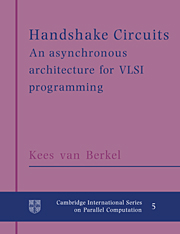Book contents
- Frontmatter
- Contents
- Foreword
- Preface
- 0 Introduction
- 1 Introduction to Tangram and handshake circuits
- 2 Examples of VLSI programs
- 3 Handshake processes
- 4 Handshake circuits
- 5 Sequential handshake processes
- 6 Tangram
- 7 Tangram → handshake circuits
- 8 Handshake circuits → VLSI circuits
- 9 In practice
- A Delay insensitivity
- B Failure semantics
- Bibliography
- Glossary of symbols
- Index
9 - In practice
Published online by Cambridge University Press: 14 January 2010
- Frontmatter
- Contents
- Foreword
- Preface
- 0 Introduction
- 1 Introduction to Tangram and handshake circuits
- 2 Examples of VLSI programs
- 3 Handshake processes
- 4 Handshake circuits
- 5 Sequential handshake processes
- 6 Tangram
- 7 Tangram → handshake circuits
- 8 Handshake circuits → VLSI circuits
- 9 In practice
- A Delay insensitivity
- B Failure semantics
- Bibliography
- Glossary of symbols
- Index
Summary
Handshake circuits and the associated compilation method from CSP-based languages were conceived during 1986 at Philips Research Laboratories. A first IC (7000 transistors) was designed using experimental tools to manipulate and analyze handshake circuits (then called “abstract circuits”) and to translate them into standard-cell netlists. The IC realized a subfunction of a graphics processor [SvB88] and proved “first-time-right” (September 1987). Extensive measurements hinted at interesting testability and robustness properties of this type of asynchronous circuit [vBS88].
Encouraged by these early results the emphasis of the research shifted from the design of the graphics processor to VLSI programming, compilation methods, and tool design. Generalization and systematization of the translation method resulted in an experimental silicon compiler during spring 1990 [vBKR+91]. Section 9.0 describes these compilation tools and their application to a simple Compact Disc error decoder.
A second test chip was designed and verified during the autumn of 1991 [vBBK+93, RS93]. In addition to some test structures, the IC contains a simple processor, including a four-place buffer, a 100-counter, an incrementer, an adder, a comparator, and a multiplier in the Galois field GF(28). The Tangram program was fully automatically compiled into a circuit consisting of over 14 thousand transistors. Section 9.1 discusses this chip and its performance in detail. This chapter concludes with an appraisal of asynchronous circuits in Section 9.2.
VLSI programming and compilation
Experiences with VLSI programming and compilation will be presented from a programmer's viewpoint.
- Type
- Chapter
- Information
- Handshake CircuitsAn Asynchronous Architecture for VLSI Programming, pp. 175 - 194Publisher: Cambridge University PressPrint publication year: 1994



